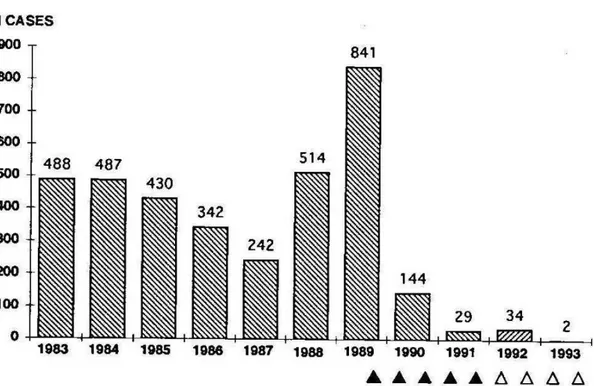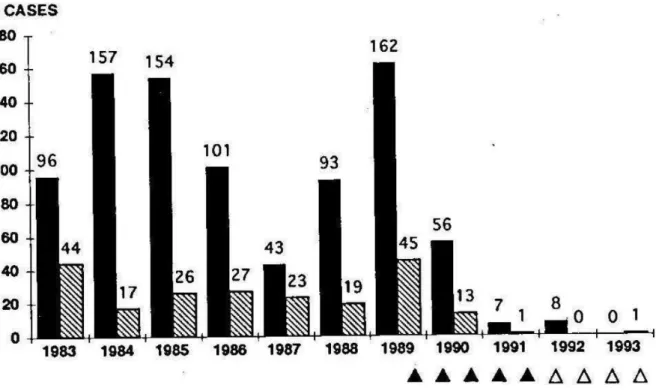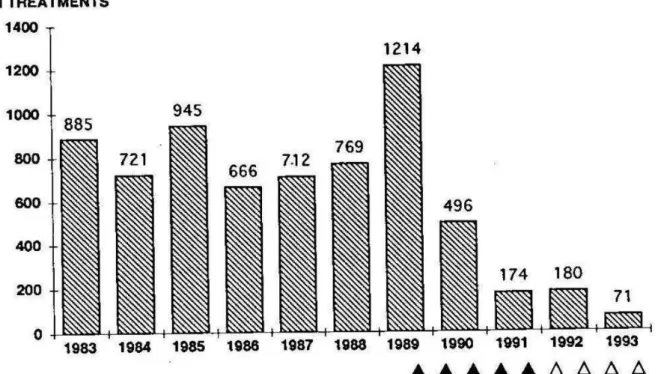Towards rabies elimination in Belgium by fox vaccination
using a vaccinia-rabies glycoprotein recombinant virus
Bernard Brochier*, Denise Boulanger*, Françoise Costy and Paul-Pierre Pastoret*
*Department of Immunology - Vaccinology, Faculty of Veterinary Medicine, University of Liege, B43 Sart Tilman, B-4000 Liege, Belgium. Rabies Unit, Pasteur Institute of Brabant, Rue Engeland 642, B-1180 Brussels, Belgium.
KEYWORDS: Rabies; vaccinia-rabies vaccine; recombinant; glycoprotein ABSTRACT
Oral immunization of foxes by distributing vaccine baits was experimentally assessed and subsequently employed in the whole of the infected area of Belgium (10000 km²). A vaccinia-rabies glycoprotein recombinant virus (VR-G) was used as vaccine because of its efficacy, safety and heat stability. Five 'full' campaigns of fox vaccination, carried out from 1989 until 1991, induced a drastic decrease in the incidence of rabies. The disease has disappeared from the major part of the initial infected area. In 1992 and 1993, three 'defence' campaigns, carried out along international borders, completely eliminated rabies virus infection from the fox population in 1993.
Published in : Vaccine (1994), vol.12, n°15, pp.1368-1371 DOI: 10.1016/0264-410x(94)90143-0
Status : Postprint (Author’s version)
•
•
In Belgium, as in other countries of Western Europe, the red fox is the vector and reservoir of the current endemic of sylvatic rabies. Since rabies control by reducing the fox population was not achieved, oral immunization of foxes, by distribution of vaccine baits, was experimentally assessed and subsequently used in all infected countries of Europe. The principle of this control method consists of the immunization of a fraction of the fox population, which is sufficient to reduce the efficacy of rabies transmission, thus disrupting the viral infection chain [1] The three main requirements of a live virus vaccine to be used in the field are efficacy, safety and heat stability. Therefore, a recombinant vaccinia virus expressing the immunogenic glycoprotein of rabies virus (V-RG) has been developed [2] and extensively tested in the laboratory as well as in the field [3-7]. This vaccine is currently being used on a large scale in France, the Grand Duchy of Luxemburg and Belgium. Field trials are also in progress in the USA for oral vaccination of racoons. As shown in Figure 1, Belgium was heavily infected before the campaigns of fox vaccination. The rabies- infected area covered 10000 km2 in the southern part of the country.
Rabies has been endemic since 1981 and its incidence remained high, especially during 1989 when 841 animal rabies cases were recorded.
NATIONAL PROGRAMME OF SYLVATIC RABIES CONTROL
PROTOCOL OF VACCINATION CAMPAIGNS
In the autumn of 1989, the first campaign of fox vaccination was carried out throughout the whole of the infected area. Subsequently, similar 'full' campaigns were performed four times: two in the spring and autumn of 1990 and two in the spring and autumn of 1991 [8, 9]. Each time, 150000 V-RG baits were dispersed by air at a mean density of 15 km².
Regarding the geographical evolution of rabies in Belgium and in adjacent regions in neighbouring countries, a new spatial strategy for bait dispersal was planned for 1992 and 1993. Four successive 'defence' campaigns were carried out in a reduced vaccination area that formed an immune belt along political borders [10] The protocol of fox vaccination campaigns is summarized in Table 1. The campaigns of bait dispersal, carried out by the Veterinary Inspectorate of the Ministry of Agriculture, were financially supported by the Ministry of Agriculture and the Commission of the European Union.
VACCINE BAIT SYSTEMS
In the autumn of 1989 and the spring of 1990, SAD B19 and V-RG vaccines were used to treat the whole of the infected area; from the autumn of 1990, the V-RG vaccine was used alone.
The SAD B19 vaccine [11] is an attenuated strain of rabies virus adapted to and grown on baby hamster kidney (BHK) cloned cells. It was produced by the Rabies Centre of the Federal Research Institute in Tiibingen, West Germany. One dose consisted of 1.8 ml of virus suspension contained in a hermetically sealed capsule. The vaccine stock was stored at -20°C until distribution in the field. The Tiibingen fox bait' consisted of a machine-made mixture of fat, bone and fishmeal enclosing a vaccine capsule.
Figure 1. Geographial distribution of 841 animal rabies cases in Belgium in 1989. e. Wild animals (n=520); . domestic animals (n=321). Infected area: 10000 km² F, France; G, Germany; L, Grand Duchy of Luxemburg; N, the Netherlands.
Table 1. Protocol of fox vaccination campaigns in Belgium
Campaign Year Season Vaccine Treated Aera
(km²)
Dispersal Method
1 Full 1989 Autumn SAD B19a 8000 Manual
V-RGb 2 000 Helicopter
2 Full 1990 Spring SAD B19 8000 Helicopter
V-RG 2 000 Helicopter
3 Full 1990 Autumn V-RG 10 000 Plane
4 Full 1991 Spring V-RG 10000 Plane
5 Full 1991 Autumn V-RG 10000 Plane
6 Defence 1992 Spring V-RG 8500 Plane
7 Defence 1992 Autumn V-RG 8000 Plane
8 Defence 1993 Spring V-RG 8 000 Helicopter
9 Defence 1993 Autumn V-RG 5600 Helicopter
a Attenuated strain of rabies virus
b Vaccinia-rabies glycoprotein recombinant virus
V-RG (Rabora®) is a recombinant vaccina virus (Copenhagen strain) expressing the glycoprotein of rabies virus (ERA strain). The vaccine suspension consisted of the supernatant of a BHK cell culture infected with V-RG. The viral suspension medium was a saline solution added with gentamicin (125µg/dose).
The baiting system [12] was formed from an appetent mixture of fish meal (50%) and fish oil (11%) aggregated using a hydrophobic synthetic polymer (11%). A sealed polyethylene sachet containing 2.5 ml liquid vaccine (titrating 108-109 CCID50) was fixed into the bait with a binding
agent (11%). Tetracycline hydrochloride, introduced into the appetent mixture bait (150 mg/bait), served as a biomarker of bait uptake.
Published in : Vaccine (1994), vol.12, n°15, pp.1368-1371 DOI: 10.1016/0264-410x(94)90143-0
Status : Postprint (Author’s version)
This machine-made vaccine bait system formed a rigid 5 x 3 x 2 cm parallelipiped weighing 34-40 g. Vaccine baits, stored at 4°C until use, were dropped by helicopter or plane according to a grid, resulting in a mean density of 15 baits km²; urban areas and stretches of water were not seeded.
EFFICACY CONTROLS
After each vaccination campaign, foxes found dead or shot by hunters were collected for bone tetracycline analysis (bait uptake control) and rabies diagnosis Tetracycline was detected
in animal bones (left jaw) by ultraviolet fluorescence microscopy of a 400 µm transverse
section (diamond saw, Isomet-Büehler). The presence of brain rabies virus was determined by
immunofluorescence and inoculation of murine neuroblastoma cells as recommended by the World Health Organization [13].
RESULTS
The five 'full' campaigns covering the whole of the infected area induced a drastic decrease in the incidence of rabies (Figure 2) and the elimination of the disease from the major part of the initial infected area. As shown by geographical distribution of rabies cases in 1992 (Figure 3), the spatial pattern of rabies has changed: all fox cases recorded were within 20 km of the border with France and more than 70% were less than 5 km from the border. At this time, France reported numerous rabies cases in the contiguous area.
The successive 'defence' campaigns carried out in 1992, combined with vaccination operations in neighbouring countries, induced the complete elimination of fox rabies in 1993 (Figure 3). During this year, two rabies cases (one badger and one domestic cat) were still detected close to international borders. According to the recommendations of the World Health Organization [13] epidemiological surveillance by controlling a maximum number of foxes has been increased. Figure 4 shows the geographical distribution of 488 rabies-negative foxes, collected in 1993. Because notification of cases of rabies in cattle is mandatory in Belgium, the incidence of rabies in domestic livestock provides a reliable indicator of the prevalence of rabies in the wild. Figure 5 plots the number of notified cases of rabies in cattle over a 1 1-year period before and during the vaccination campaigns. No case of cattle rabies has been recorded in Belgium since December 1992.
Similarly, as a second consequence of fox rabies control, only one rabies case was reported in domestic carnivores over 2 years (Figure 5). This could have a beneficial effect on the free movement of pets within the European Community by abolishing quarantine containment in some disease-free countries.
Figure 2. Evolution of animal rabies incidence in Belgium; data from 1 January 1983 to 31 December 1993. 'Full' campaigns of fox vaccination (10000 km²), 'defence' campaigns (8500-5600 km²)
Figure 3. Geographical distribution of animal rabies cases in 1992 and 1993. 1992: 34 rabies cases in a 2000 km² area; 17 wild animals; 17 domestic animals. 1993: Two rabies cases: one wild animal (badger; March 1993); one domestic animal (domestic cat; December 1993)
Published in : Vaccine (1994), vol.12, n°15, pp.1368-1371 DOI: 10.1016/0264-410x(94)90143-0
Status : Postprint (Author’s version)
Figure 4. Geographical distribution of 488 rabies-negative foxes collected in 1993
Figure 5. Evolution of rabies in cattle () and domestic carnivores ( ); data from 1 January 1983 to 31 December 1993. , 'Full' campaigns of fox vaccination; , 'defence' campaigns
Figure 6. Evolution of human vaccination (postexposure schedule); data from 1 January 1983 until 31 December 1993. , 'Full' campaigns of fox vaccination; , 'defence' campaigns
Figure 7. Estimation of the fox population immune status by the use of tetracycline biomarking. Results obtained in 136 foxes collected during the last quarter of 1992 and the first quarter of 1993. A: Area treated seven times from 1989 until 1992; B: area treated five times from 1989 until 1991. , Tetracycline-positive foxes; , tetracycline-negative foxes
Published in : Vaccine (1994), vol.12, n°15, pp.1368-1371 DOI: 10.1016/0264-410x(94)90143-0
Status : Postprint (Author’s version)
The number of people who received medical treatment (curative vaccination schedule) after coming into contact with a suspected animal has also decreased markedly (Figure 6); 71 people were treated in 1993, of whom only six were really exposed to an animal confirmed as infected during that year.
At the beginning of 1993, the current immune status of the fox population could be estimated by using tetracycline biomarking. As shown in Figure 7, two areas were defined in the previously infected area (10 000 km²). The first area (A) was treated seven times from 1989 to 1992 and formed an immune belt along the international borders. The second area (B) was treated five times: fox vaccination was stopped in 1992 because of the absence of rabies cases for 1 year in this region. In the A area, the bait uptake rate determined from tetracycline status was 82%. When estimating a fox population density of two individuals per km², this percentage of immunized foxes would be sufficient for the elimination of rabies virus infection from the fox population [1]. That prediction was confirmed by the epidemiological situation observed in 1993.
In the B area, only 51% of foxes were shown to be positive for tetracycline. This lower value can be explained by considering the turnover of the fox population occurring in the spring of 1992 (unvaccinated offspring). Thus, the vaccine coverage observed in the B area was not sufficient to break the cycle of rabies infection and retransmission. In spite of this, the persistent absence of rabies in this region provides proof that rabies virus had been eliminated from the fox population by the five previous campaigns.
CONCLUSIONS
Sylvatic rabies has been eliminated from the majority of the initial infected area of Belgium after five fox vaccination campaigns. Such a result could be obtained within 2 years by using an efficient and heat-stable vaccine-bait association. Nevertheless, the creation of immune belts along borders was required to prevent the spread of rabies from infected regions in neighbouring countries.
A surveillance area including Belgium and adjacent regions in neighbouring countries at 50 km around Belgium has been defined. Further spatial strategies or potential interruption of fox vaccination will depend on the rabies evolution in this surveillance area. A complete interruption will be justifiable when this zone has been rabies-free for 1 year.
In 1993, positive ethical and economic consequences of fox rabies control were obtained in the fields of public health, domestic animal health and environmental monitoring.
ACKNOWLEDGEMENTS
The authors are grateful to the following individuals and organizations who collaborated with the program of fox vaccination campaigns or have been involved in the project: the Veterinary Inspectorate of Ministry of Agriculture and the Forestry Rangers of the General Directorate of
Natural Resources and Environment (Ministry of Région Wallonne) for the collection of dead foxes; Dr A. Marchal for his collaboration in rabies diagnosis; D. Péharpré, R. Beyer, F. Mosselmans and B. Bauduin for their technical assistance. Controls of vaccination campaigns are supported by a grant from the Ministry of Région Wallonne for Natural Resources and Environment. Vaccination campaigns are paid for by the Belgian Federal Ministry of Agriculture and the Commission of the European Union (DG VI).
Published in : Vaccine (1994), vol.12, n°15, pp.1368-1371 DOI: 10.1016/0264-410x(94)90143-0
Status : Postprint (Author’s version)
References
1. Anderson, R.M., Jackson, H.C., May, R.M. and Smith, A.D. Population dynamics of fox rabies in Europe. Nature (London) 1981, 289, 765
2. Kieny, M.P., Lathe, R., Drillien, R., Spehner, S., Skory, D., Schmitt T. et al. Expression of rabies virus glycoprotein from a recombinant vaccinia virus. Nature (London) 1984, 312, 163
3. Blancou, J., Kieny, M.P., Lathe, R., Lecocq, J.P., Pastoret, P.-P., Soulebot, J.P. and Desmettre, P. Oral vaccination of the fox against rabies using a live recombinant vaccinia virus. Nature (London) 1986, 322, 373
4. Brochier, B., Thomas, I., Bauduin, B., Leveau, T., Pastoret, P.-P., Languet, B. et al. Use of a vaccinia-rabies recombinant virus for the oral vaccination of foxes against rabies. Vaccine 1990, 8, 101
5. Pastoret, P.-P., Brochier, B., Blancou, J., Artois, M., Aubert, M.F.A., Kieny, M.P. et al. Development and deliberate release of a vaccinia-rabies recombinant virus for the oral vacination of foxes against rabies. In: Recombinant Poxviruses (Eds Smith, G.L. and Binns, M.) CRC Press, Boca Raton, FL, 1992, pp. 163--206 6. Brochier, B., Kiény, M.P., Costy, F., Coppens, P., Bauduin, B., Lecocq, J.P. et al. Large-scale eradication of rabies using recombinant vaccinia-rabies vaccine. Nature (London) 1991, 354, 520
7. Rupprecht, C.E., Hanlon, C.A., Cummins, L.B. and Koprowski, H. Primate responses to a vaccinia-rabies glycoprotein recombinant virus vaccine. Vaccine 1992, 10, 368
8. Brochier, B, Costy, F., Hallet, L., Duhaut, R, Péharpré, D., Afiademanyo, K. et al. Contrôle de la rage en Belgique. Résultats obtenus après trois campagnes de vaccination du renard roux. Ann. Méd. Vét. 1991, 135, 191
9. Coppens, P., Brochier, B., Hallet, L., Péharpré, D., Duhaut, R., Costy, F. et al. Lutte contre la rage en Belgique: bilan épidémiologique 1991 et stratégie future. Ann. Méd. Vét. 1992, 136, 129
10. Brochier, B., Coppens, P., Costy, F., Péharpré, D., Marchal, A., Hallet, L. et al. Programme d'éradication de la rage en Belgique par la vaccination du renard: bilan 1992. Ann. Méd. Vét. 1993, 137, 285
11. Schneider, L.G. and Cox, J.H. Ein Feldversuch zur oralen lmmunisierung von Füchsen gegen die Tollwut in der Bundes- republik Deutschland. I. Unschädlichkeit, Wirksamkeit und Stabilität der Vakzine SAD B19. Tierärstl. Umsch. 1983, 38, 315
12. Brochier, B.M., Languet, B., Artois, M., Zanker, S., Guittre, C., Blancou, J. et al. Efficacy of a baiting system for fox vaccination against rabies with vaccinia-rabies recombinant virus. Vet. Rec. 1990, 127, 165
13. World Health Organization. Comite OMS D'experts de la Rage. Huitième Rapport Technique; 824, Geneva, Switzerland, 1992, p. 44



